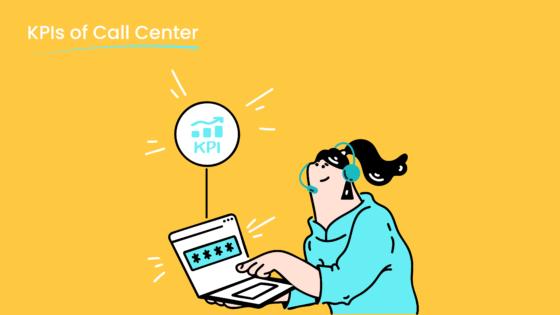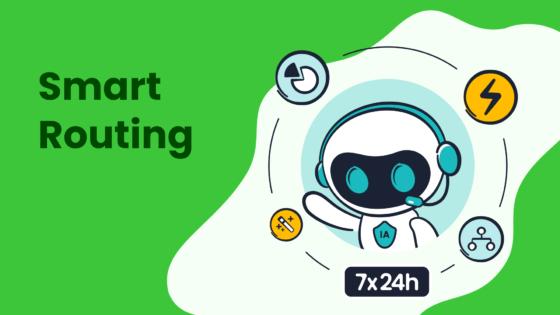Boost Your NPS with These 10 Survey Questions

How do you know if your customers truly love your brand? Net score promoter questions are your gateway to understanding customer loyalty and satisfaction. Studies show that a 7% increase in NPS can lead to a 1% revenue boost, while promoters spend up to 67% more on average. Clearly, customer satisfaction surveys aren’t just about feedback—they’re about growth.

But here’s the catch: poorly crafted questions frustrate respondents and lead to ineffective decisions. With the right questions, though, you can uncover actionable insights that enhance customer experiences. That’s where Sobot comes in. By integrating NPS surveys into its Voice/Call Center, Sobot helps you gather meaningful feedback and improve customer interactions seamlessly.
Understanding Net Promoter Score (NPS)

Definition of Net Promoter Score
The net promoter score is a simple yet powerful way to measure customer loyalty. It asks one key question: "How likely are you to recommend us to a friend or colleague?" Customers respond on a scale from 0 to 10, and their answers reveal how they feel about your brand. Those who score 9 or 10 are your Promoters—your biggest fans. Scores of 7 or 8 are Passives, while 0 to 6 are Detractors, who may not be satisfied.
This metric, introduced by Fred Reichheld in 2003, has become a global standard for understanding customer satisfaction. Over time, it has evolved from basic surveys to dynamic tools that collect feedback through apps, websites, and even AI-powered platforms like Sobot's Voice/Call Center. These advancements make it easier to gather real-time insights and improve customer experiences.
How NPS is calculated
Calculating the net promoter score is straightforward. First, categorize your customers based on their responses:
- Promoters (9-10): Loyal customers who actively recommend your brand.
- Passives (7-8): Neutral customers who are satisfied but not enthusiastic.
- Detractors (0-6): Unhappy customers who may discourage others.
Next, use this formula:
[
\text{Net Promoter Score} = % \text{Promoters} - % \text{Detractors}
]

For example, if 60% of your customers are Promoters and 20% are Detractors, your NPS is 40. This score helps you understand how well you're meeting customer expectations. Tools like Sobot's AI solutions can analyze these scores and provide actionable insights to improve your business.
Why NPS is essential for customer-centric businesses
The net promoter score isn't just a number; it's a window into your customers' minds. Businesses that focus on NPS often outperform their competitors. For instance, a study by Qualtrics XM Institute found that Promoters are four times more likely to repurchase and seven times more likely to try new products.
Companies like Glassdoor and HotelTonight have used NPS to identify customer pain points and make meaningful changes. By addressing issues raised by Detractors and nurturing Promoters, these businesses have improved satisfaction and loyalty. With tools like Sobot's Voice/Call Center, you can segment feedback, track trends, and act quickly to close the feedback loop. This approach not only boosts your NPS but also strengthens your relationship with customers.
Top 10 NPS Survey Questions for 2025
Primary NPS Question
The cornerstone of any NPS survey is the primary question: "On a scale of 0 to 10, how likely are you to recommend [Your Company/Product/Service] to a friend or colleague?" This question is simple yet powerful. It captures the essence of customer loyalty and satisfaction in one concise query.
Why does this question work so well? It’s straightforward, easy to understand, and provides actionable quantitative data. Studies show that customers respond better to clear, direct questions, reducing confusion and survey fatigue. For example, companies like Samsung have successfully used this question to gather feedback and improve their Net Promoter Score.
Pairing this question with follow-ups is key. For instance, asking "What is the primary reason for your score?" helps you dive deeper into customer sentiment. Tools like Sobot’s Voice/Call Center make it easy to collect and analyze responses, ensuring you don’t miss valuable insights.
Pro Tip: Timing matters. Send this question after a significant customer interaction, like a purchase or support call, to capture fresh and relevant feedback.
Follow-Up Questions for Promoters (Score 9-10)
Promoters are your brand’s cheerleaders. They love what you do and are likely to recommend you to others. But don’t stop at their high scores—dig deeper to understand why they’re so satisfied. Here are some follow-up questions tailored for Promoters:
- "What did you enjoy most about your experience with us?"
- "What features or services stood out to you?"
- "How can we continue to exceed your expectations?"
These questions help you identify your strengths and understand what keeps Promoters loyal. For example, if customers rave about your fast shipping or friendly support team, you’ll know to prioritize those areas.
Research shows that engaging Promoters can boost loyalty even further. By asking them to elaborate on their positive experiences, you can uncover insights that strengthen your brand. Sobot’s AI-powered Voice/Call Center can segment Promoter feedback and highlight recurring themes, making it easier to act on their suggestions.
Did You Know? Promoters spend up to 67% more than other customers. Use their feedback to refine your offerings and encourage repeat purchases.
Follow-Up Questions for Passives (Score 7-8)
Passives are satisfied but not enthusiastic. They’re unlikely to recommend your brand, but they’re also not actively dissatisfied. To turn Passives into Promoters, you need to understand their hesitations. Here are some targeted follow-up questions:
- "What could we have done differently to improve your experience?"
- "Where did we fall short in delivering the ideal experience?"
- "How likely are you to consider alternatives to our product/service in the future?"
These questions uncover pain points and areas for improvement. For instance, if Passives mention slow response times or unclear communication, you can address those issues directly. Sobot’s AI solutions make it easy to analyze Passive feedback and identify trends, helping you take actionable steps to enhance their experience.
Quick Tip: Engage Passives with personalized follow-ups. A simple acknowledgment of their feedback can make them feel valued and more likely to recommend your brand.
By asking the right follow-up questions, you can turn Passives into loyal customers and boost your Net Promoter Score.
Follow-Up Questions for Detractors (Score 0-6)
Detractors are your most critical customers, but they’re also your biggest opportunity for growth. These are the people who scored you between 0 and 6 on your NPS survey questions. Their feedback can reveal the gaps in your service or product that need immediate attention. To turn their dissatisfaction into loyalty, you need to ask the right follow-up questions.
Here are some examples of tailored questions for Detractors:
| Respondent Type | Follow-Up Question |
|---|---|
| Detractor (0-6) | What was missing in your experience with us? |
| Detractor (0-6) | What could we have done to meet your needs? |
| Detractor (0-6) | What specific issue caused you to rate us low? |
These questions help you pinpoint the exact reasons behind their dissatisfaction. For instance, if a customer mentions poor response times, you can prioritize improving your support team’s efficiency. Sobot’s Voice/Call Center can assist by analyzing call data and identifying recurring issues, ensuring you address the root causes effectively.
Tip: Always acknowledge Detractors’ feedback promptly. A simple “Thank you for sharing your experience” can make them feel heard and valued. Following up with a personalized solution can turn a negative experience into a positive one.
By engaging Detractors thoughtfully, you show them that their opinions matter. This approach not only improves your NPS but also strengthens your brand’s reputation.
Additional Insightful Questions
While the primary NPS question and follow-ups are essential, adding a few open-ended questions can uncover deeper insights. These questions allow customers to share their thoughts freely, providing context that numbers alone can’t capture.
Consider including these additional questions in your NPS survey:
- "What’s one thing we could do to improve your experience?"
- "What motivated you to choose our product/service?"
- "How does our product compare to your expectations?"
Qualitative surveys are vital for understanding the emotions behind customer feedback. As one study highlights, open-ended questions are key to gathering nuanced opinions that help you see the bigger picture. For example, if customers frequently mention unclear instructions, you can refine your product documentation or onboarding process.
Sobot’s AI-powered solutions make it easy to analyze these responses. By identifying trends and recurring themes, you can prioritize changes that have the most significant impact. Whether it’s enhancing your product features or improving customer support, these insights guide you toward meaningful improvements.
Pro Tip: Keep your additional questions simple and focused. Overloading customers with too many questions can lead to survey fatigue, reducing the quality of responses.
Adding these thoughtful questions to your NPS survey questions ensures you capture a well-rounded view of your customers’ experiences. This strategy not only boosts your NPS but also helps you build stronger, more loyal relationships.
Best Practices for Crafting Effective NPS Surveys

Keep the survey short and focused
When it comes to NPS surveys, less is more. A short and focused survey respects your customers' time and increases the likelihood of them completing it. Research shows that lengthy surveys often lead to drop-offs, leaving you with incomplete data. Stick to the essentials—your primary NPS question and a few follow-ups.
For example, if you're using Sobot's Voice/Call Center, you can automate the process to ensure surveys are concise and delivered at the right time. This not only saves time for your team but also makes the experience seamless for your customers.
Tip: Aim for surveys that take no more than 2-3 minutes to complete. This keeps respondents engaged and ensures higher response rates.
Use clear and concise language
Clarity is key when crafting NPS survey questions. Using simple, straightforward language ensures your questions are easy to understand. Avoid technical jargon or complex words that might confuse respondents. For instance:
- Replace "What is your perception of our product's usability?" with "How easy is it to use our product?"
- Use direct phrases like "What could we improve?" instead of "What areas require enhancement?"
This approach reduces miscommunication and makes your surveys more user-friendly. According to experts, clear language also minimizes the risk of respondents misinterpreting questions, leading to more accurate feedback.
Pro Tip: Brevity matters. Keep your questions short to avoid overwhelming your audience.
Personalize the survey for your audience
A one-size-fits-all survey rarely works. Tailoring your NPS surveys to specific customer segments can uncover deeper insights. For example, you might ask loyal customers about their favorite features, while new users could share their first impressions.
Here’s how personalization can make a difference:
- Identify loyal customers and ask what keeps them coming back.
- Target disengaged users to understand why they’re not purchasing.
- Segment by demographics to gather insights that inform marketing strategies.
Sobot’s AI-powered solutions make this process easier by analyzing customer data and segmenting responses automatically. This way, you can craft surveys that resonate with each group, leading to more meaningful feedback.
Did You Know? Personalized surveys not only improve response rates but also help you design better products and services tailored to your customers' needs.
By keeping your surveys short, clear, and personalized, you’ll gather actionable insights that truly reflect your customers’ experiences. This approach doesn’t just boost your Net Promoter Score—it strengthens your relationship with your audience.
Time your survey appropriately (e.g., after a purchase or interaction)
Timing is everything when it comes to NPS surveys. If you send your survey at the wrong moment, you risk getting incomplete or irrelevant feedback. The best time to ask customers about their experience is right after a meaningful interaction. Whether it’s a purchase, a support call, or a product delivery, catching them while the experience is fresh ensures you get accurate responses.

For example, if a customer just completed a purchase, they’re more likely to share their thoughts on the buying process. Similarly, after a support call, you can gauge how well your team resolved their issue. Sobot’s Voice/Call Center makes this process seamless by automating survey delivery at the perfect moment. With features like smart call tracking and time zone support, you can ensure surveys reach customers when they’re most likely to respond.
Pro Tip: Avoid sending surveys during busy periods like holidays or weekends. Customers may overlook them, leading to lower response rates.
Timing your surveys appropriately doesn’t just improve response rates—it also helps you gather actionable insights that reflect real customer experiences. This strategy is key to boosting your Net Promoter Score and building stronger relationships with your audience.
Act on the feedback you receive using Sobot's AI-powered insights
Collecting feedback is only half the battle. Acting on it is where the magic happens. When you analyze customer responses, you uncover opportunities to improve your products, services, and overall experience. Sobot’s AI-powered solutions make this process effortless. By leveraging tools like sentiment analysis and trend identification, you can turn raw data into actionable insights.
Many leading brands have seen remarkable results by acting on feedback with AI:
- Marriott International improved guest experiences by identifying areas for improvement across its properties.
- Amazon optimized product listings and development based on customer reviews.
- McDonald's enhanced menu items and staff training by monitoring real-time sentiment.
- Delta Air Lines prioritized baggage handling improvements based on customer feedback.
Sobot’s Voice/Call Center offers similar capabilities. It segments responses by Promoters, Passives, and Detractors, helping you focus on what matters most. For instance, if Detractors frequently mention poor communication, Sobot’s AI can pinpoint the exact moments where issues arise. You can then implement changes, like improving call routing or training your support team, to address these concerns.
Quick Tip: Always close the feedback loop. Let customers know how their input influenced your decisions. This builds trust and encourages future participation.
By acting on feedback with Sobot’s AI-powered insights, you don’t just improve your Net Promoter Score—you create a customer experience that keeps people coming back.
Leveraging NPS Survey Results with Sobot's Solutions
Segment responses by Promoters, Passives, and Detractors
Segmenting your NPS responses is the first step to unlocking actionable insights. By categorizing customers into Promoters, Passives, and Detractors, you can tailor your strategies to meet their unique needs. Here's a quick breakdown:
| NPS Segments | Characteristics | Strategies |
|---|---|---|
| Promoters | Score 9-10, loyal advocates, likely to recommend | Recognize loyalty, offer exclusive deals, maintain communication |
| Passives | Score 7-8, satisfied but not loyal | Elevate experience, understand needs, offer personalized interactions |
| Detractors | Score 0-6, dissatisfied, risk negative feedback | Address concerns, offer resolutions, rebuild trust |
Sobot’s Voice/Call Center simplifies this process by automatically segmenting responses. For example, Promoters can be identified and rewarded with exclusive perks, while Detractors can receive personalized follow-ups to address their concerns. This segmentation ensures you focus on the right customers and take targeted actions to improve your NPS.
Tip: Use Sobot’s AI-powered tools to analyze feedback trends within each segment. This helps you prioritize changes that matter most to your customers.
Identify trends and recurring themes in feedback
Once you've segmented your responses, the next step is identifying patterns. Trends and recurring themes in customer feedback reveal what’s working and what needs improvement. Sobot’s AI-powered analytics make this process effortless.
| Feature | Description |
|---|---|
| Theme Detection with Business Impact Analysis | Automatically identifies themes from feedback and quantifies their impact on key metrics like NPS and CSAT. |
| Sentiment Analysis Tuned for CX | Analyzes sentiment across comments, providing contextual emotional data. |
| AI-Powered Root Cause Detection | Identifies not just what changed, but why, linking feedback spikes to specific themes or events. |
For example, if customers frequently mention slow delivery times, Sobot’s tools can pinpoint this issue and quantify its impact on satisfaction. By understanding these themes, you can prioritize improvements that drive the biggest results.
Pro Tip: Use sentiment analysis to uncover emotional cues in feedback. This helps you understand not just what customers say, but how they feel.
Implement changes based on actionable insights
Insights are only valuable if you act on them. Companies that analyze feedback and implement changes often see significant growth. For instance:
- Retailers improve service by mapping the customer journey to identify friction points.
- Targeted promotions based on shopper behavior boost conversion rates.
- Businesses that close the feedback loop build stronger customer relationships.
Sobot’s Voice/Call Center helps you implement these changes seamlessly. Its call tracking and AI-powered analysis ensure you address recurring issues effectively. For example, if Detractors highlight poor communication, you can refine your call routing system or train agents to handle inquiries better.
Closing the feedback loop is equally important. Inform customers about the changes you’ve made based on their input. This reassures them that their voices matter and builds trust. Sobot’s video call recordings allow teams to revisit conversations, improving communication strategies and strengthening connections.
Quick Tip: Always follow up with customers after implementing changes. Letting them know their feedback influenced your decisions boosts loyalty and satisfaction.
By leveraging Sobot’s solutions, you can turn insights into action, improve your NPS, and create a customer experience that stands out.
Close the feedback loop by following up with respondents using Sobot's Voice/Call Center
Closing the feedback loop is one of the most effective ways to improve your Net Promoter Score (NPS). When customers take the time to share their thoughts, they expect you to act on it. Following up shows them you value their input and are committed to making changes. This simple step can turn Detractors into loyal fans and strengthen relationships with Promoters.
Sobot’s Voice/Call Center makes following up easy and efficient. With features like call tracking and AI-powered insights, you can identify key issues and address them directly. For example, if a customer mentions poor communication, Sobot’s smart call routing ensures they’re connected to the right agent next time. You can even use its AI-powered Voicebot to automate follow-ups, saving time while maintaining a personal touch.
Did You Know? Studies show that businesses that close the feedback loop see up to a 12% increase in customer retention.
Here’s how you can use Sobot’s Voice/Call Center to close the loop effectively:
- Personalized Follow-Ups: Reach out to customers with tailored solutions based on their feedback. For instance, if a Detractor highlights a delayed delivery, offer a discount or expedited shipping on their next order.
- Real-Time Monitoring: Use Sobot’s call tracking to analyze interactions and identify recurring issues. This helps you address problems before they escalate.
- Global Reach: With access to phone numbers worldwide, you can follow up with customers across different regions, ensuring no feedback goes unnoticed.
By following up, you show customers their opinions matter. Sobot’s tools make this process seamless, helping you build trust and improve customer satisfaction. Ready to close the loop? Learn more about Sobot’s Voice/Call Center here.
How Sobot Helps Businesses Improve Their Net Promoter Score
Integration of NPS surveys into Sobot's Voice/Call Center
Integrating your net promoter score surveys into Sobot's Voice/Call Center is a game-changer. It simplifies the process of collecting and analyzing customer feedback. With Sobot, you can embed NPS surveys directly into your customer interactions, whether through calls, chats, or emails. This seamless integration ensures you capture feedback at the right moment—when the experience is still fresh in your customers' minds.
For example, after a support call, Sobot’s system can automatically send an NPS survey to the customer. This eliminates manual follow-ups and ensures no feedback opportunity is missed. Plus, with features like smart call routing and global number availability, Sobot makes it easy to reach customers wherever they are. By embedding surveys into your workflow, you not only improve response rates but also gather more accurate insights to enhance customer satisfaction.
Pro Tip: Use Sobot’s AI-powered Voicebot to automate survey distribution, saving time while maintaining a personal touch.
Real-time monitoring and analysis of survey data
Real-time monitoring is essential for staying ahead of customer expectations. Sobot’s Voice/Call Center provides live analytics, allowing you to track NPS survey results as they come in. This means you can address issues immediately instead of waiting for monthly reports.
Here’s how real-time data benefits your business:
- Increased Business Efficiency: Quickly identify and resolve data issues, saving resources.
- Improved Customer Experience: Act on feedback instantly to enhance interactions and build loyalty.
- Enhanced Decision-Making: Make informed choices based on up-to-date information.
For instance, if a trend shows Detractors frequently mention long wait times, you can adjust staffing levels or optimize call routing. Sobot’s tools ensure you’re always working with the most current data, helping you shift from reactive to proactive strategies.
Did You Know? Businesses using real-time analytics often see a significant boost in customer retention and operational efficiency.
AI-powered tools for actionable insights
Sobot’s AI-powered tools take your net promoter score analysis to the next level. These tools process survey data in seconds, uncovering patterns and themes that might take hours to identify manually. Whether you’re using Google Forms, Typeform, or SurveyMonkey, Sobot’s platform integrates seamlessly to deliver instant, actionable insights.
Here’s what makes Sobot’s AI tools stand out:
- They detect recurring themes and patterns in customer feedback using advanced algorithms.
- Natural language processing helps identify emotional cues, giving you a deeper understanding of customer sentiment.
- Automated insights extraction allows you to focus on strategic decisions rather than sifting through raw data.
For example, if multiple customers mention unclear instructions, Sobot’s AI can flag this as a recurring issue. You can then prioritize improving your product documentation or onboarding process. By leveraging these insights, you make data-driven decisions that directly impact customer satisfaction and loyalty.
Quick Tip: Use Sobot’s AI to segment feedback by Promoters, Passives, and Detractors. This helps you tailor your strategies to each group effectively.
Success stories, such as Samsung's improved NPS with Sobot

When it comes to improving your net promoter score, Samsung’s story is a perfect example of what’s possible with the right tools. As one of the world’s leading tech brands, Samsung faced a massive challenge: managing countless customer inquiries across multiple channels. They needed a solution that could unify their communication systems and deliver a seamless experience. That’s where Sobot stepped in.
Samsung integrated Sobot’s all-in-one contact center solution into its operations. This move transformed how they handled customer interactions. By unifying communication channels like calls, chats, and emails, Samsung’s team could respond faster and more effectively. Sobot’s AI-powered tools also helped them analyze customer feedback in real time. This allowed Samsung to identify pain points and act on them immediately.
The results were remarkable. Samsung achieved a 97% customer satisfaction rate and boosted agent efficiency by 30%. These improvements directly impacted their net promoter score, turning more customers into loyal Promoters. For example, VIP customers received personalized video support, which strengthened their connection to the brand. Sobot’s smart call routing and data integration ensured that every interaction felt smooth and professional.
Samsung’s success shows how powerful Sobot’s solutions can be. By addressing customer concerns quickly and efficiently, you can improve satisfaction and loyalty. Whether you’re a global brand or a growing business, tools like Sobot’s Voice/Call Center can help you achieve similar results. Ready to take your net promoter score to the next level? Learn more about Sobot’s solutions here.
Asking the right NPS survey questions is your key to unlocking meaningful customer feedback. It’s not just about gathering opinions—it’s about driving growth. Did you know that a 7% boost in NPS can lead to a 1% increase in revenue? For a business earning $100 million annually, that’s an extra $1 million in sales. Companies with higher NPS scores grow faster because loyal customers stick around and spend more.
By implementing the top 10 survey questions and following best practices, you can turn insights into action. Tools like Sobot’s Voice/Call Center make this process seamless. From automating surveys to analyzing feedback, Sobot helps you improve customer satisfaction and loyalty effortlessly. Ready to elevate your NPS? Start asking the right questions today!
FAQ
What is the best time to send an NPS survey?
The best time is right after a meaningful interaction, like a purchase or support call. This ensures the experience is fresh in your customer’s mind. Sobot’s Voice/Call Center automates survey timing, so you never miss the perfect moment to gather feedback.
Tip: Avoid sending surveys during holidays or weekends to maximize response rates.
How can I improve my NPS score quickly?
Focus on Detractors first. Address their concerns with personalized follow-ups and solutions. Use tools like Sobot’s AI-powered insights to identify recurring issues and fix them. For example, improving response times or clarifying product instructions can make a big difference.
Did You Know? Closing the feedback loop can increase customer retention by up to 12%.
Can I use NPS surveys for different customer segments?
Absolutely! Segmenting your surveys helps you gather more targeted insights. For instance, ask loyal customers about their favorite features and new users about their first impressions. Sobot’s AI tools make segmentation easy by analyzing customer data automatically.
Pro Tip: Tailored surveys lead to higher response rates and more actionable feedback.
How does Sobot’s Voice/Call Center enhance NPS surveys?
Sobot integrates NPS surveys directly into customer interactions, automating the process. It offers real-time analytics, AI-powered insights, and global reach. For example, Samsung used Sobot to boost its NPS by improving agent efficiency and personalizing customer experiences.
Learn more about Sobot’s Voice/Call Center here.
Why is acting on NPS feedback so important?
Feedback without action is a missed opportunity. Acting on NPS feedback shows customers you value their input. Sobot’s tools help you analyze responses, identify trends, and implement changes. This builds trust and loyalty, turning Detractors into Promoters.
Quick Tip: Always inform customers about changes made based on their feedback.
See Also
Improve Customer Satisfaction With These 10 Live Chat Tips
Enhance Call Center Efficiency Through Effective Monitoring Strategies
Maximize Your Live Chat Efficiency Around The Clock
Discover 10 Advantages Of Implementing A Chatbot On Your Site
